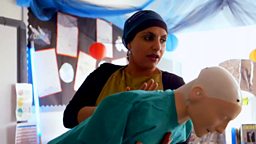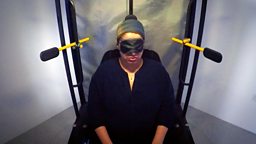What is giant cell arteritis and how can I recognise it?
Giant cell arteritis, or GCA, is a condition where arteries in the head and neck become inflamed.

It is called ‘giant cell’ because abnormally large cells accumulate in the artery walls. One of the arteries that is commonly affected provides blood to the optic nerve, and if the optic nerve is starved of blood it can lead to irreversible sight loss. Every year an estimated 3000 people lose some or all of their sight due to GCA.
GCA tends to affect adults over 50, although most people who develop the condition are over 60. It is around seven times more common in white people than in black people and three times more common in women than in men. People are also more likely to develop GCA if they have been diagnosed with a condition called polymyalgia rheumatica, or PMR.
One of the problems with GCA is that it can come on suddenly and get to a dangerous stage very quickly. However if it is spotted in time it can be treated with steroids and sight can be saved. The key is recognising the red flag symptoms in time.
What are the symptoms to look out for?
- Headache – headaches in GCA usually develop suddenly and are often extreme. They tend to affect one side of the head and the temples. Patients often described these headaches as being unlike any they’ve experienced before. Painkillers are usually ineffective.
- Tenderness – the head and scalp can feel very tender, to the extent that it feels sore to brush your hair and in some cases the arteries in the temples are visibly swollen.
- Jaw pain – this typically occurs when chewing , talking or swallowing, in some cases pain is felt in the tongue.
- Drenching night and day sweats, weight loss, tiredness, lethargy and aches and pains – often pain occurs in the neck and shoulders.
- Vision problems – these affect 1 in 5 people with GCA and can affect one or both eyes. Some patients have described the visual disturbance as being like having a shade covering their eye. Many people also experience episodes of double vision or blurred vision and sometimes sight vanishes entirely.
The above symptoms usually develop quickly but some other symptoms can also start weeks or months earlier, such as weight loss, sweats, tiredness, mild fever, loss of appetite and depression.
Treatment
Fortunately if GCA is spotted quickly it can be treated before sight loss occurs. Treatment starts with a high dose of about 40-60mg of steroids but this is reduced over time. After 2-3 years the condition can go away, but some people require treatment for longer.
However, one of the problems with this condition is that very few people are aware of it – often patients don’t realise what their symptoms mean, and even medical professionals have sometimes found it difficult to spot. That’s why a new set of guidelines are now being rolled out across the NHS which will help identify GCA quickly and give sufferers the treatment they need as soon as possible.
This new ‘fast track’ pathway for GCA was pioneered by Prof Bhaskar Dasgupta and his team at Southend University Hospital. In 2013 they published the results of an evaluation study that showed that the use of this pathway dramatically reduced the number of cases of full or partial sight loss. The pathway involved a dedicated phone line for GPs to use, and the guarantee that the patient would be seen by a rheumatologist within 24 hours. Suspected cases of GCA were checked with ultrasound, which clearly reveals when GCA is present as arteries that are affected are surrounded by a dark band due to swelling of the vessel wall on the ultrasound, known as the ‘halo sign’.
These new guidelines, along with an increased public awareness of the red flag symptoms, will hopefully lead to GCA being recognised and treated more quickly so that patients no longer find themselves living with sudden and devastating sight loss.
Polymyalgia Rheumatica (PMR)
People with a condition called polymyalgia rheumatica, or PMR can be at risk of developing GCA. Similarly, around half of patients with GCA also develop PMR. This is an inflammatory illness that causes severe pain and stiffness in the muscles around the shoulders, neck and hips. The symptoms of PMR are similar to other rheumatic conditions like rheumatoid arthritis and include:-
- Muscle stiffness – in the morning and lasting longer than 45 mins
- Difficulty getting out of bed, reaching and rising
- Temperature/fever & sweating
- Extreme tiredness
- Loss of appetite and weight loss
- Depression
Treatment for PMR is corticosteroids (usually prednisolone) starting at 15mg daily and tapering off over time. After a few years the disease can recede and people recover, but sometimes the illness can be more complex and lasts longer.





















































